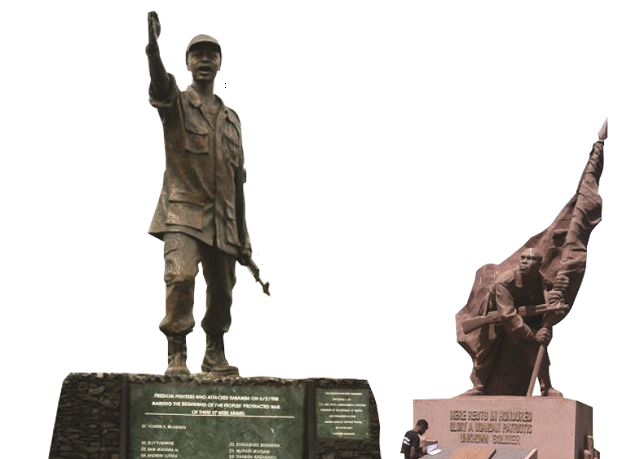
A universal urge to immortalise persons and achievements
The urge to put a human face to national achievements with a view to immortalise the person’s association to the achievement appears universal. The avenue mostly used in this enterprise is monumental art in recognition of its latent power to influence mindsets and build larger-than-life impressions of personalities and events. This phenomenon transcends civilizations and continues unabated and Uganda has not been spared.
Sometimes the politicians who commission the works stamp their image on them as in the `Heroes Monument’ at Kabamba Military Barracks in western Uganda.
It was sculpted to celebrate the attack by rebels led by then-rebel leader Yoweri Museveni
on the same barracks on February 6, 1981. This attack is considered a pivotal moment in the rebellion that brought President Museveni to power and is celebrated as Tarehe Sita; a national holiday.
Commissioned by the government, renowned sculptors George Kyeyune, Maria Naita and the Kann Artists represented this history in a 20-metre tall sculpture made out of fibre glass.
It presents an erect, youthful Yoweri Museveni holding a Kalashnikov in his left arm, with his right lifted high firmly and pointing forward as if ordering a charge. According to Makerere University art scholar, Dr. Angelo Kakande, in addition, the Heroes Monument’s narrative of heroism is embodied in a charismatic, militaristic, and sitting president and is intended to inspire a sense of patriotism.
Figuratively, the artists engaged the socialist realism seen in monuments in communist Russia, China, Cuba and North Korea, among others.
Perhaps in contrast, the government also commissioned `The Journey’ which depicts five people of different genders and age, in an ascending row, looking skyward as they climb a flight of steps. Their leader carries aloft the national flag to which those closest to him raise their arms in support. It is mounted on a pedestal at the Independence Grounds of the Kololo National Recreational Grounds in Kampala, which is a befitting location as this monumental appears to celebrate national, rather than individual achievement.
“The five youthful individuals represent the five decades Uganda has passed through as an independent state,” elaborates Dr. Kyeyune, who worked on the monument to mark Uganda’s Golden Jubilee anniversary from October 9, 1962 to October 9, 2012.
The government also commissioned the `Unknown Soldier’, which was done by a Korean company in 2012 also as part of the celebration of Uganda at 50 years. It follows in a worldwide tradition of honouring the unidentified men and women who die in war. So the Unknown Soldier as a theme was not new. However, this ‘unknown soldier’ is seen struggling to plant a flag into the ground ostensibly after scoring a military victory. The gargantuan concrete sculpture is also located at the Kololo National Ceremonial Grounds, a fitting location for a monument of national valour.
****
editor@independent.co.ug
 The Independent Uganda: You get the Truth we Pay the Price
The Independent Uganda: You get the Truth we Pay the Price


